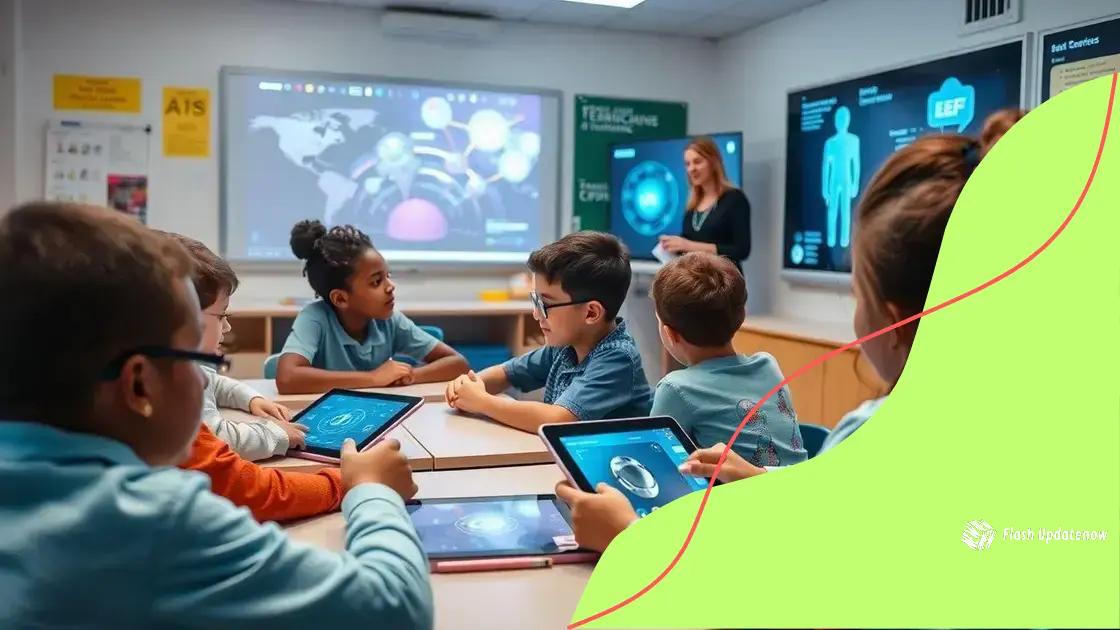AI curriculum integration: revolutionizing education

AI curriculum integration enhances education by personalizing learning, improving student engagement, and providing valuable data insights while posing challenges like resource limitations and the need for teacher training.
AI curriculum integration is changing the landscape of education, making learning more personalized and engaging for students. Have you ever thought about how technology can reshape classrooms? Let’s explore this fascinating topic.
Understanding AI curriculum integration
Understanding AI curriculum integration is vital for modern education. It involves incorporating artificial intelligence technologies into the classroom to enhance learning experiences. But what does it truly mean for teachers and students?
AI curriculum integration helps personalize education. By using data to tailor lessons, teachers can meet each student’s needs better. This leads to more effective learning outcomes. For instance, AI tools can analyze student performance and suggest resources to help them improve.
Benefits of AI in Education
Implementing AI in the classroom offers several advantages:
- Personalization: Tailor lessons based on individual learning styles.
- Efficiency: Automate administrative tasks, allowing teachers to focus on teaching.
- Engagement: Interactive tools keep students interested and motivated.
- Data-driven insights: Use analytics to track progress and adapt teaching methods.
As educators explore AI, they must consider the tools available—ranging from adaptive learning platforms to AI-powered tutoring systems. These technologies not only track performance but also foster collaborative learning environments.
Furthermore, integrating AI in education encourages critical thinking among students. By working with AI tools, students learn to analyze information effectively. This prepares them for a future where technology and human skills must coexist.
The dialogue surrounding AI curriculum integration also needs to address the potential challenges. Issues like data privacy and the digital divide remain important to discuss as we embrace these new technologies in classrooms.
In summary, understanding AI curriculum integration is a step toward future-ready education. It empowers both students and teachers, ensuring a more engaging and effective learning journey.
Steps for effective implementation
Implementing AI in education is a process that requires careful planning. Understanding the steps for effective implementation can help schools maximize the benefits of technology.
First, it’s important to assess the current curriculum. Identifying areas where AI can make a difference is crucial. Once identified, schools should design a pilot program to test AI tools in selected classes.
Key Steps to Implement AI
The following steps can guide educators through the integration process:
- Training staff: Provide professional development for teachers to understand AI tools.
- Setting goals: Define clear objectives for what the school hopes to achieve with AI integration.
- Engaging stakeholders: Involve parents and community members in the decision-making process.
- Evaluating outcomes: Regularly assess the impact of AI on student learning and adjust strategies as needed.
Once the pilot is running, gather feedback from students, teachers, and parents. This feedback is vital to understand what works and what needs improvement. Adjusting the approach based on real experiences ensures that AI integration aligns with everyone’s needs.
Moreover, continuity plays a key role. Schools should plan for long-term support and updates as AI technologies evolve. Not only does this enhance the learning environment, but it also fosters a culture of innovation.
Finally, maintaining an open dialogue about AI’s role in education is essential. Regular discussions help clarify any concerns and keep everyone informed about new developments.
Benefits of using AI in education

Learning how to maximize the benefits of using AI in education can greatly enhance teaching and learning experiences. AI opens new pathways that allow students to learn better and educators to teach more effectively.
One key benefit is personalized learning. AI can adapt to each student’s learning style and pace, ensuring that they grasp concepts before moving on. This level of customization helps every student succeed.
Key Advantages of AI
Here are some of the significant advantages of integrating AI into educational settings:
- Improved student engagement: Interactive AI tools capture students’ interest and encourage active participation.
- Accessibility: AI makes learning more accessible for students with disabilities by providing tailored resources and support.
- Efficient grading: AI can automate grading processes, allowing teachers to spend more time on instruction.
- Data-driven insights: AI analyzes student performance data to inform teaching strategies and track progress.
AI also promotes collaboration among students. By using AI-powered platforms, students can work together on projects, sharing ideas and learning from one another. This teamwork builds essential skills for the future.
Moreover, teachers benefit from AI by gaining access to vast educational resources. They can use AI-driven analytics to understand which methods work best in their classrooms, leading to continuous improvement in teaching practices.
Finally, it’s important to consider how AI prepares students for the future. In an increasingly digital world, being familiar with AI tools is crucial. By using AI in education, schools help students develop the skills they need for the workforce.
Challenges educators might face
While there are many benefits of AI in education, educators may also face several challenges during its implementation. Understanding these challenges helps schools prepare better.
One significant challenge is the lack of resources. Schools may not have access to the necessary technology or training to effectively utilize AI tools. Without proper funding, it’s hard to keep up with the latest advancements in AI education.
Common Challenges Faced by Educators
Here are some of the key challenges educators might encounter:
- Resistance to change: Some teachers may be hesitant to adopt new technologies, preferring traditional methods.
- Data privacy concerns: Protecting students’ personal information is critical, and many educators worry about data breaches.
- Training needs: Teachers need adequate training to use AI tools effectively; without it, they may struggle to implement AI in the classroom.
- Equity issues: There’s a risk of widening the gap between students with access to technology and those without.
Additionally, navigating the vast array of AI tools can be overwhelming. With so many options, how does one choose the right technology? Educators may feel pressure to select AI programs that best suit their unique classroom needs.
Another hurdle is ensuring that AI tools accurately reflect the diversity of students. If AI programs are not designed with inclusivity in mind, they may not meet the needs of all learners. This poses a critical issue for educators striving to create equitable learning environments.
By being aware of these challenges, educators can work proactively to address them. Open communication among staff, ongoing professional development, and careful planning can help pave the way for a smoother integration of AI in education.
Future trends in AI curriculum integration
As we look ahead, the future trends in AI curriculum integration are set to transform education even further. Staying informed about these trends is essential for educators who want to use AI effectively.
One significant trend is the growing emphasis on adaptive learning technologies. These AI systems customize educational experiences based on individual student performance. They can adjust content delivery, making learning more engaging and effective.
Emerging Trends to Watch
Here are some of the key trends that educators should pay attention to:
- AI-powered assessments: Tools that provide real-time feedback and tailored evaluations will help teachers understand student needs better.
- Collaborative learning environments: AI will facilitate collaborative projects across borders, allowing students from different regions to work together using technology.
- Enhanced content creation: AI tools will support teachers in developing dynamic and interactive learning materials that captivate students’ attention.
- Focus on soft skills: AI will help foster skills like creativity, collaboration, and critical thinking through specialized programs.
Another important aspect is the integration of AI ethics into the curriculum. As students learn to use AI, understanding ethical considerations will be crucial. Educators need to guide students on responsible AI use and the implications of technology on society.
Furthermore, the role of data privacy will continue to gain importance. As AI tools collect data to personalize learning, educators must be aware of the necessary steps to protect student information.
Ultimately, keeping an eye on these emerging trends allows schools to prepare for the evolving landscape of AI in education. By embracing these changes, educators can enhance their teaching methods and create better learning opportunities for students.
FAQ – Frequently Asked Questions about AI Curriculum Integration
What are the main benefits of integrating AI into education?
Integrating AI can personalize learning, improve engagement, and provide valuable insights into student performance.
What challenges do educators face with AI integration?
Challenges include lack of resources, resistance to change, data privacy concerns, and the need for adequate training.
How can AI enhance collaboration among students?
AI tools facilitate group projects and online interactions, allowing students from different locations to work together effectively.
Why is ethical use of AI important in education?
Teaching students about ethical AI use helps ensure responsible behavior and protects their privacy in a technology-driven world.
